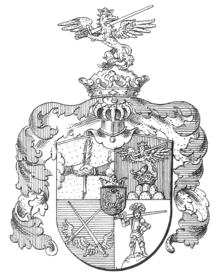Feather fencer

The feather fencers or free fencers from the spring were a German fencing school founded in the 16th century , whose masters - as was common at the time - organized public fencing and price fencing in addition to the actual fencing lessons .
A formative element of public and self-perception was their competition with the Marx brothers in the period that followed . The first comparison with these is mentioned in the 1573 "Ordinary Description of the Great Shooting in Zwickau". At the request of the respective landlords, the Nuremberg Council ordered in 1589 that the Marx brothers would have to hold their fencing schools at the “Zum Goldenen Stern” inn, while the fencers would have to use the “Heilsbronner Hof”, which was virtually an extraterritorial area of the Principality of Ansbach .
Emperor Rudolf II confirmed the statutes of the “Society of Free Fencers from the Feather” on March 7, 1607 in Prague by letter of privilege and awarded them a coat of arms, which in fact amounted to recognition as a guild and legal equality with the Marx brothers. The seal awarded to the company bore the inscription "Seal of the Masters of the Long Sword". The certificate was rediscovered in 1899 by the Bohemian fencing master Gustav Hergsell in the Neustift monastery near Olomouc :
“The letter of privileges says that Emperor Rudolph granted the Society of Pen-Feathers or Veiterfechter or the Masters of the Long Sword privileges because they stood in the open war that had been granted for so many years against the hereditary enemy of the Christian faith, the Turks Manfully rendered a great deal of benefit '. The document also contains the stipulation that feather fencers may open their school on the first Sunday after St. Vitus Day and that they may keep it open for a fortnight 'as long as the Prague Old Town Market is open'. According to the information in the document, those appointed as masters were those who either got away with it 'undefeated' or who 'ruined their counter-thail as much blood as it got'. Those fencers who could not achieve the mastery had at least the right to call themselves the 'Khajser liberated from the pen'. In the letter of privilege it is further emphasized that 'all open and closed letters and communal matters and other matters of the type issued by the rulers' are sealed in red wax with the seal awarded by the emperor. 'All these privileges' - so it says in the document -' are to be held by our heirs and subsequent customers for eternity. It is announced to our subjects, knights, all captains and primases of all three Prague cities, present and future, that they must not prevent the master free fencers from exercising their privileges, but rather have to protect and shield them in difficult situations Punishment and disgrace. A penalty of `` winty-five Marckh Löttigen Geldes '' is set for offenders, `` which every one, as often as he acted negligently, has to pay by pen for half our chamber and the other half of the ark of the masters and free fencers. "
With a diploma dated December 2, 1688, Emperor Leopold I allowed the fencing masters to call themselves “masters of the long sword of Greyffenfels over the company of the Frey fencers from the pen” and increased their coat of arms.
The term Federfechter possibly goes back to Veiterfechter , ie "Fechter of St. Vitus". Their headquarters were in Prague with its St. Vitus Cathedral , which is why they chose St. Vitus as their patron saint . Candidates for master craftsmen were tried on St. Vitus Day, i. H. tested in their weapon skills. For this, the exercise “in all 7 knightly defenses” and the parachute sword was necessary.
To what extent the use of Fechtfeder has contributed as a training weapon for popularizing the term "Federfechter" is controversial. Both coats of arms (1607 and 1688) are talking coats of arms . They show two hands protruding from clouds, holding a quill, and two feathered swords that cross each other.
literature
- Marxbrüder and Federfechter in: Karl Friedrich Wilhelm Wander (Hrsg.): Deutsches Sprich emphasis -Lexikon , Volume 3. Leipzig 1873, Sp. 476 ( Zeno.org ).
- Sebastian Keller: Modern sword fighting trainers as heirs of old masters . Inaugural dissertation, University of Regensburg, 2017 ( online ).
- W. Roux: Instructions for fencing with straight and crooked blades. Verlag F. Mauke, Jena 1840, pp. 11-14 ( books.google.de ).
- Gustav Adelbert Seyler: J. Siebmacher's large and general book of arms. Volume I, Dept. 7. Bauer & Raspe, Nuremberg 1898, p. 40 f. & Panel 42 ( Lower Saxony SUB Göttingen ).
- Werner Ueberschär: Archives from the Nuremberg State Archives and City Archives. A preliminary work for a story of the Marx brothers and Federfechter in Nuremberg . Sword Association Nurmberg e. V. (Ed.), 2014 ( online ).
- Friedrich Wilhelm Karl Waßmannsdorf: Six fencing schools (ie show and price fencing) of the Marx brothers and feather fencers from the years 1573 to 1614; Nuremberg fencing school rhymes from 1579 and Rösener's poem: Honorary title and praise for the art of fencing from 1589 . Heidelberg 1870, pp. 12-16 ( online ).
Individual evidence
- ^ Friedrich Wilhelm Karl Waßmannsdorf: Six fencing schools (etc.) . Heidelberg 1870, pp. 12-16.
- ↑ Sebastian Keller: Modern sword fighting trainers as heirs of old masters . 2017, p. 75 .
- ^ Werner Ueberschär: Archives from the Nuremberg State Archives and City Archives. 2014, p. 12 f.
- ↑ a b c Marxbrüder and Federfechter in: Karl Friedrich Wilhelm Wander (ed.). Leipzig 1873, Sp. 476.
- ↑ a b c Gustav Adelbert Seyler: J. Siebmacher's […] Wappenbuch, Volume I, Dept. 7. 1898, p. 40.
- ^ A letter of privileges from Emperor Rudolph II. In: Wiener Zeitung , February 1, 1899, p. 19 (online at ANNO ).
